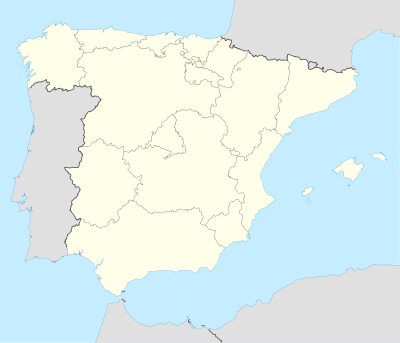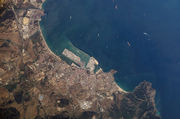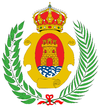Algeciras
| Algeciras | |||
|---|---|---|---|
| — Municipality — | |||
 |
|||
|
|||
 Algeciras
|
|||
| Coordinates: | |||
| Country | |||
| Autonomous community | Andalusia | ||
| Province | Cádiz | ||
| Comarca | Campo de Gibraltar | ||
| Judicial district | Algeciras | ||
| Founded | Pre-Roman | ||
| Government | |||
| - Alcalde | Tomás Herrera Hormigo (2007) (PSOE) | ||
| Area | |||
| - Municipality | 86 km2 (33.2 sq mi) | ||
| Elevation | 20 m (66 ft) | ||
| Population (2009) | |||
| - Municipality | 116,209 | ||
| - Density | 1,351.3/km2 (3,499.8/sq mi) | ||
| - Metro | 263,739 | ||
| Demonym | Algecireño, ña, Especial | ||
| Time zone | CET (UTC+1) | ||
| - Summer (DST) | CEST (UTC+2) | ||
| Postal code | 11200-11209 | ||
| Dialing code | (+34) 956/856 | ||
| Official language(s) | |||
| Website | Official website | ||
Algeciras (Spanish pronunciation: [alxeˈθiɾas]) is a port city in the south of Spain, and is the largest city on the Bay of Gibraltar (in Spanish, the Bahía de Algeciras). Port of Algeciras is one of the largest ports in Europe and in the world in three categories: container, cargo and transhipment. It is situated on the Río de la Miel 20 km north of Tarifa, which is the southernmost town of the Iberian peninsula and continental Europe. It has a population in 2009 of 116,209 people.
It is the biggest city among its metropolitan area, that also includes the municipalities of Los Barrios, La Línea de la Concepción, Castellar de la Frontera, Jimena de la Frontera, San Roque and Tarifa, with a population of 263,739.[1]
Contents |
Name
The site of Roman cities called Portus Albus, Caetaria (current Getares) and Iuliua Tracta, the current name of Algeciras seems to come from the Arab occupation of the Iberian Peninsula: AlJazīra AlKhadrā' Arabic الجزيرة الخضراء or Green Island.
History
The area of the city has been populated since prehistory, and the earliest remains belong to Neanderthal populations from the Paleolithic. Due to its strategic position it was an important port under the Phoenicians, and was the site of the relevant Roman port of Portus Albus ("White Port"), with two near cities called Caetaria (most likely Iberians) and Iulia Transducta (Tarifa), founded by the Romans themselves. After being destroyed by the Germanic Barbarians and their Vandal allies, the city was founded again in 711 by the invading Moors, as the first city created by the Arabs on the occupied Spanish soil. It enjoyed a brief period of independence as a taifa state from 1035-1058. It was named al-Jazirah al-Khadra' ("Green Island") after the offshore Isla Verde; the modern name is derived from this original Arabic name (compare also Algiers and Al Jazeera). In 1344 the city was reconquered by Alfonso XI of Castile. It was retaken by the Moors in 1368, but was destroyed on the orders of Muhammed V of Granada. The site was subsequently abandoned.
Algeciras was refounded in 1704 by refugees from Gibraltar following the territory's capture by Anglo-Dutch forces in the War of the Spanish Succession. It was rebuilt on its present rectangular plan by Charles III of Spain in 1760. In July 1801, the French and Spanish navies fought the British Royal Navy offshore in the Battle of Algeciras, which ended in a British victory.
The city hosted the Algeciras Conference in 1906, an international forum to discuss the future of Morocco which was held in the Casa Consistorial (town hall). In July 1942 Italian frogmen set up in a secret base in the Italian tanker Olterra which was interned in Algeciras to attack shipping in Gibraltar. During the Franco era, Algeciras underwent substantial industrial development, creating many new jobs for the local workers made unemployed when the border between Gibraltar and Spain was sealed by Franco between 1969 and 1982.

In 1982 there was a failed plan codenamed Operation Algeciras conceived by the Argentinian military to sabotage the British military facilities in Gibraltar during the Falklands War. The Spanish authorities intervened just before the attack, and deported the two Argentine Montoneros and military liaison officer involved.[2]
Demographics
Source: INE (Spain)
Economy

Algeciras is principally a transport hub and industrial city. Its principal activities are connected with the port, which serves as the main embarkation point between Spain and Tangier and other ports in Morocco as well as the Canary Islands and the Spanish enclaves of Ceuta and Melilla. It is ranked as the 16th busiest port in the world. The city also has a substantial fishing industry and exports a range of agricultural products from the surrounding area, including cereals, tobacco and farm animals.
- Port of Algeciras
In recent years it has become a significant tourist destination, with popular day trips to Tarifa to see bird migrations; to Gibraltar, to see the territory's unusual sights and culture; and to the Bay of Gibraltar on whale watching excursions.
Algeciras is the southern terminus of two principal north-south Euroroutes, the E05 and E15. Both routes, moreover, run to Scotland (the E05 terminates at Greenock and the E15 at Inverness) via France and England.
Climate
| Climate data for Algeciras | |||||||||||||
|---|---|---|---|---|---|---|---|---|---|---|---|---|---|
| Month | Jan | Feb | Mar | Apr | May | Jun | Jul | Aug | Sep | Oct | Nov | Dec | Year |
| Average high °C (°F) | 16.1 (61) |
16.7 (62.1) |
17.8 (64) |
18.9 (66) |
21.7 (71.1) |
24.4 (75.9) |
27.2 (81) |
27.8 (82) |
26.1 (79) |
21.7 (71.1) |
18.9 (66) |
16.7 (62.1) |
21.2 (70.2) |
| Daily mean °C (°F) | 13 (55) |
14 (57) |
15 (59) |
16 (61) |
19 (66) |
21 (70) |
24 (75) |
24 (75) |
23 (73) |
19 (66) |
17 (63) |
14 (57) |
18 (64) |
| Average low °C (°F) | 11.1 (52) |
11.1 (52) |
12.2 (54) |
13.3 (55.9) |
15.6 (60.1) |
17.8 (64) |
20.0 (68) |
20.6 (69.1) |
20.0 (68) |
16.7 (62.1) |
13.9 (57) |
12.2 (54) |
15.4 (59.7) |
| Precipitation mm (inches) | 121.9 (4.799) |
106.7 (4.201) |
106.7 (4.201) |
66.0 (2.598) |
38.1 (1.5) |
10.2 (0.402) |
0.0 (0) |
2.5 (0.098) |
25.4 (1) |
76.2 (3) |
149.9 (5.902) |
132.1 (5.201) |
835.7 (32.902) |
| Source: The Weather Channel[3] | |||||||||||||
Tourism
- Parque Natural del Estrecho
- Parque Natural Los Alcornocales
Transport

The bus urban transport in managed by C.T.M. (Cooperativa de transporte de Marruecos).
- Bus lines:
- Line 1: Bajadilla-Pajarete
- Line 2: Colinas-San Bernabé-Reconquista
- Line 3: Rinconcillo
- Line 4: La Granja
- Line 5: Bahía de Algeciras
- Line 6: Juliana
- Line 7: Saladillo
- Line 8: San García-Saladillo
- Line 9: San García Directo
- Line 10: El Cobre
- Line 11: La Piñera
- Line 12: San García playa
- Line 16: Cementerio-Centro Penitenciario
- Line 18: Cortijo Vides-Piñera
- Line 19: Puerto-S.J.Artesano-Rinconcillo
- Line 21: San García - Residencia - Puerto - Parque
- The rail line to Ronda, Cordoba and elsewhere terminates near the port.
- The road that crosses Algeciras are:
- European route E15
- European route E05
- Autopista AP-7
- Autovía A-48
- N-340
- GR 7
- The nearest airports are:
- Gibraltar Airport - to 20 km.
- Jerez Airport - to 100 km.
- Málaga Airport - to 120 km.
In addition, the Algeciras Heliport is being built for transport to Ceuta and other areas in the region.
Monuments
.jpg)
- Hornos Romanos del Rinconcillo (first century B.C.). (furnaces)
- Factoría de salazones de la calle San Nicolás (first century). (salt meat factory)
- La Villa Vieja, torres de la Huerta del Carmen (tenth century). (Towers)
- Parque Arqueológico de las Murallas Meriníes (thirteenth century). (Archeological Park)
- Capilla de Nuestra Señora de Europa (1690). (Chapel)
- Iglesia de Nuestra Señora de la Palma (1736). (Church)
- Hospital de La Caridad, (1748).
- Capilla de la Caridad (1752). (Chapel)
- Casa Consistorial (1756). (City Council)
- Capilla de San Servando (1774). (Chapel)
- Capilla del Santo Cristo de la Alameda (1776). (Chapel)
- Plaza Alta (1807).
- Mercado de Abastos de Algeciras of engineer Eduardo Torroja Miret (1935). (Supplies Market)
- Art School Building. (1971) architect: Fernando Garrido Gutiérrez.
- Faro de Isla Verde. Project of Jaime Font, constructed in 1864). (Light)
- Hotel Reina Cristina (1901).
- District de San Isidro, typical district designed in the twentieth century.
- Hotel Howard Chiu (1823)
Celebrations

- Arrastre de latas (5, January).
- Feria Real de Algeciras (June).
- Fiestas patronales en honor de Ntra. Sra. la Virgen de la Palma (August).
- Fiesta de los Tosantos (1, November).
- Carnival of Algeciras.
Sports
- Algeciras CF, currently in Primera División de Andalucía.
- Algeciras BM, currently in Liga ASOBAL.
Education
Universidad de Cádiz - Campus Bahia de Algeciras
The following education centres are property of the University of Cádiz:
- Escuela Politécnica Superior de Algeciras
- Escuela Universitaria de Enfermería de Algeciras
- Escuela Universitaria de Estudios Jurídicos y Económicos del Campo de Gibraltar "Francisco Tomás y Valiente"
- Escuela Universitaria de Magisterio "Virgen de Europa"
- Centro Universitario de Derecho de Algeciras (CUDA)
- Campus Bahia de Algeciras (Spanish) (English)
Native People
- Paco de Lucía
- Al-Mansur Ibn Abi Aamir
- Ana Belén Palomo
- José María Sánchez-Verdú
- Alejandro Sanz
- Irene Cookie
Sister city
References
- Algeciras. Encyclopædia Britannica Online, 2006.
- Algeciras. The Columbia Encyclopedia, 2004
- Lonely Planet Andalucia, Lonely Planet, 2005
External links
- (Spanish) Ayuntamiento de Algeciras
- (Spanish) Expoalgeciras: Images Gallery (History and present from Algeciras with old and current photographys]
|
|||||

